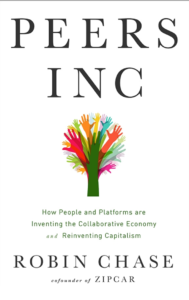 Robin Chase. Thank you for taking the time to share with us. I have been influenced by your work, both in theory and practice.
Robin Chase. Thank you for taking the time to share with us. I have been influenced by your work, both in theory and practice.
Much of your work seems to stem from networks – transportation, communication, etc. and your core company is called Meadow Networks, which is described as “a consulting firm that advises transportation and planning departments at city, state, and federal government agencies, and NGOs about wireless and mesh networking applications in the transportation sector, and impacts on innovation and economic development.” You do a lot of other things too like serving on the Board of the World Resources Institute, the US Secretary of Commerce’s National Advisory Committee for Innovation & Entrepreneurship, and the US Department of Transportation’s Intelligent Transportation Systems Program Advisory Committee.
Why is “network” at so much of the core of what you do?
Because we have 35,000 years of human history – and everything that is to be discovered in silos has been discovered. We’re close to the limit of what we can learn in siloed specialties. And today what is new — and can be innovated upon — is in the connection between.
I went to business school. If you had a problem in your company, one solution was to flip to the other possible organizational structure – decentralized to centralized or vice versa. And now there is a new option: distributed. Distributed networks can happen in real time and on the fly. They are alive and organic and strong. They fascinate me.
Another reason to love, cultivate, and seek out networks is a totally different one. The road ahead for humans is a difficult one given how long we’ve taken to address the climate crisis. I think we need to exercise our community muscle and build in community muscle memory. We need to practice it. So that when the going gets tougher, our knee jerk muscle memory kicks in and we will turn to community.
You co-founded Zipcar. It was a profound innovation on two fronts, at least, helping to address climate issues with an innovative business model. How did you go about figuring that out?
Zipcar had a number of things going for it. First, we leveraged excess capacity. And because we did that, we were able to give people cost savings. Prior to Zipcar, people had two ways in which to consume a car, and both required them to buy more than they wanted: rent a car in 24 hour bundles (whether you want 2 or 26 hours); or to purchase one, despite the fact that you’ll only use it about 5% of the time. So by letting people just pay for what they use, economics was on our side.
Second, we built an online platform to make a complex process dead simple. We used technology to let our members do things that had been previously restricted to employees (choosing the car; gaining independent access to it; walking around it to determine that it was in fine condition).
Lastly, we engaged our users as our co-creators and collaborators. Zipcar was founded in 2000. Today, this is increasingly a practice. In car rental, the customer is on the other side of the counter – the company would choose the car and do a walk around before and after each rental. They definitely didn’t trust the customer. In our model, we brought the customer to our side of the counter. We trust you to look the car over, to help improve the service, select parking spaces… We saw our customers as inside as collaborators. Zipcar was a pioneer.
More recently, you have taken the Zipcar concept one step further with Buzzcar in France. Can you say how you expanded the model and why?
Zipcar could only place cars where we would get a return on our investment. And that would be where where we were sure there would be enough use. People would ask all the time, “When are you putting in a Zipcar in our neighborhood?” Often the answer was probably never because we couldn’t see getting enough use on that vehicle to pay off the cost of it. With Buzzcar, we could transcend that that limitation because we let people rent out their own cars to their friends and neighbors. We were tapping into the excess capacity of people’s own cars, that sat around idle most of the time. These cars have already been paid for and the owner perceives they are getting their money’s worth on it. This means that each and every rental of their personal car to a stranger is new income! So, even in rural places, or neighborhoods where people don’t usually rent a car, the economics works out. If someone only rents their car once a year, that is fine.
Buzzcar put the building out of the company’s locations into the hands of the users. Prior to this model, you had to wait for the car-sharing company, government etc to decide to locate in your area. We deliver the power for them to do it themselves.
Buzzcar merged with the French company Drivy, from whom you can rent other people’s cars (or rent out your own to others).
Since then you have written a book, Peers Inc, and started sharing the concept. I see Peers Inc as a Social Ecosystem Design pattern. Can you share what that pattern is?
The pattern of Peers Inc. is a two-sided collaboration, between people (the Peers) and a platform (the Inc). You’ll recognize this rise of this new organizational model in companies like Airbnb and Uber, Wikipedia and Yelp, smartphones and apps, as well as the open data movement, massive online open courses, and Bitcoin. The three building blocks I learned from Zipcar hold true in each one of these examples. Excess capacity is being harnessed on a platform for participation that engages a diversity of peers.
What is interesting about this collaboration is that each side of the collaboration is doing what they do best. The Peers provide the customized, specialized, localized, creative, adaptive elements. This stems naturally from the diversity that is found in the small scale. The Inc uses its talents to build the platform. It does all the things that are difficult or impossible for individuals or small-scale local companies: big investments over many years; the coordination of many kinds of expertise; the application of standards and standardization. The platform coordinates all the small parts, makes the complex simple, delivers economies of scale. Each side of the collaboration does what they do best. With Peers Inc, we are getting the best of both worlds.
In the world before industrialization, our work product was highly unique and often variable. You wouldn’t be able to predict the quality of items between towns or between providers without experiencing them yourself. Industrialism helped standardize things, make them broadly available, and, with economies of scale, deliver them at very low cost.
Today, with this new Peers Inc organizational structure, we can now have the best of both worlds. Standards and production that reduces costs and still access the unique local flavor that is better than the endless replicas. Our current highly standardized industrial world has taken standardization to the limit. The pendulum needs to come back some.
This is the path to the new sustainable collaborative economy, with specific roles for government, for big companies, and for small companies and individuals. Each does what they do best, and leaves an opening (and enough value) for the other partner to want to collaborate.
One of the good things is that this way of working gives you more control over your own economic destiny (you hire yourself, rather than wait for a boss to choose you). You are also in control of your own time. Flexibility is an attribute valued by all. And then, there is the speed at which we can figure out what we are good out. if you think about 20 years ago, we had get a job, see if we were good at it and what we liked and didn’t like. Then you’d have to wait a year or more to change to something that fit you better. Today, you can now explore multiple channels at once, co-evolving your talents. With the old model of one person getting one job with benefits (security ranking above happiness), people — the smallest and most fragile economic unit — were tied to one source of income. Meanwhile, companies and governments have long known to diversity their income. This new way of working lets us do that.
But let us be clear. There are plenty of imperfections. Many people worry that this new way of work absolves companies from paying employment taxes, enforcing workplace rules, and generally taking responsibility for those who work on their behalf. These allegations have merit. This Peers Inc structure is young yet. We are in the early stages of the business model.
Elinor Ostrom, a Nobel Prize winning economist, spent her life analyzing commons that worked. She uncovered 8 principles that governed the most successful ones. While her work was wholly based on physical commons (water, or land for example), her definition of commons exactly fits these new platforms: 1) it is difficult to exclude someone from participation (within reason, anyone can put their house on Airbnb); 2) people make their economic livelihood from the commons.
So, if we apply Ostrom’s 8 principles (below), you can see how this would totally change how the participating peers are treated and how they work. Power is given to the peers to create their own rules of engagement.
| 8 Principles for Managing a Commons
1. Define clear group boundaries. 2. Match rules governing use of common goods to local needs and conditions. 3. Ensure that those affected by the rules can participate in modifying the rules. 4. Make sure the rule-making rights of community members are respected by outside authorities. 5. Develop a system, carried out by community members, for monitoring members’ behavior. 6. Use graduated sanctions for rule violators. 7. Provide accessible, low-cost means for dispute resolution. 8. Build responsibility for governing the common resource in nested tiers from the lowest level up to the entire interconnected system. – See more |
Bottom line for me: the transition to platform companies is going to happen whether we like it or not. IF we protect workers in this new way of work, I believe we have a better chance of solving many of today’s most intractable problems: climate change and income inequality. We are better able to tap into the ingenuity and innovation of a large percent of the population whose ideas were previously ignored because we didn’t hire them, or choose them, or listen to their ideas. In the new collaborative economy, people choose themselves and hire themselves. People can bring their best talents to the work at hand.
Meanwhile, society gets the benefits that come with this structure: high growth, scalability, innovation, redundancy, and flexibility. I look at the biggest problems we have: the scales are massive; the timeframes are miniscule. Peers Inc is the only organizational structure that can experiment, iterate, adapt and evolve at the speed required to get us out of this fix.
Thank you for your time and wisdom Robin.
